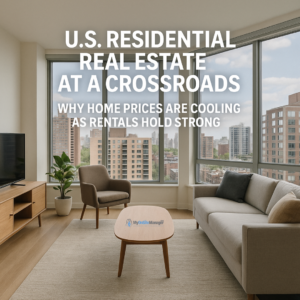The U.S. housing market is standing at a crucial turning point. After years of frenzied activity and record-high prices, signs of a cooldown in home sales and pricing are becoming more apparent even as the rental sector quietly gains strength.
For buyers, sellers, investors, and renters, these shifts highlight a market that’s far from uniform. Some areas are seeing growing inventories and softening prices, while others remain resilient. Here’s a closer look at the current trends shaping the residential real estate landscape and what they could mean for the months ahead.
1. Home Sales Cool as Inventory Rises
The once red-hot housing market is finally losing steam. Existing home sales slipped 0.5% in April and are now down 2% compared to the same period last year, according to the latest data from the National Association of Realtors (NAR).
This slowdown isn’t just about fewer buyers it’s also about more homes being listed. Inventory levels climbed 9% month over month and are up 20% year over year, the highest in nearly five years.
This increase in available properties is starting to tilt negotiating power back toward buyers, giving them more leverage to ask for concessions, repairs, or price adjustments something that was rare in the seller-dominated market of 2020–2022.
NAR Chief Economist Lawrence Yun explained that despite lower sales volume, pent-up demand remains strong. Many buyers are simply waiting for mortgage rates to ease before jumping back in. If rates drop, the market could quickly heat up again.
2. Prices Hold, but Headwinds Are Growing
For now, home prices are holding up but the cracks are starting to show.
-
The median existing home price in April reached $414,000, a 1.8% increase compared to last year.
-
The Northeast continues to lead the pack with both higher prices and stronger sales.
-
By contrast, the South and West are showing signs of stagnation or mild declines.
While modest price growth sounds reassuring, it masks a growing divide: demand is concentrated in a few resilient regions, while many other markets are losing steam.
Forecasts from Redfin predict a 1.1% drop in national home prices by year-end, assuming mortgage rates hover around 7%. Deals are also falling apart more often with 14% of homes under contract canceled in April, the highest April figure (excluding 2020) since 2017.
Why this matters: Elevated borrowing costs are pricing out many would-be buyers. Even those who can afford to purchase are often opting to wait for better rates, creating downward pressure on price growth.
3. Rental Market Shows Resilience
While the home sales market faces headwinds, the rental market is proving more stable.
-
Single-family rents increased 2.9% year over year in March the third consecutive month of rent growth.
-
Higher-end rentals led the gains, climbing 3.5%, compared to 2.1% for lower-tier units.
-
Both detached and attached properties saw similar rent growth at around 2.8%.
This steady growth suggests many Americans are choosing to rent instead of buy due to high mortgage rates. As affordability tightens, renting remains a more flexible and often less expensive option.
However, the trend isn’t uniform across the country. In markets like Dallas, where new supply is flooding in, rents actually fell 0.5% year over year. This highlights how local market conditions can dramatically shape price and rent dynamics.
4. What It Means for Different Stakeholders
For Homeowners and Sellers
-
Expect more competition as inventory grows and buyers become more selective.
-
Homes may sit longer on the market, and price reductions could become more common.
-
If your property is in a high-demand area, prices may hold but broader market momentum is shifting.
For Homebuyers
-
Rising inventory gives more options and potential room to negotiate.
-
However, high mortgage rates remain a barrier, limiting purchasing power.
-
If rates fall later in the year, buyer activity could surge making now a window for strategic offers.
For Renters
-
Renting remains a relatively stable option, especially while mortgage rates stay elevated.
-
Expect gradual rent increases, but with more negotiating power in oversupplied markets.
For Real Estate Investors
-
Rental properties may offer better returns than short-term flips in the current environment.
-
High-end rentals are performing well, but local oversupply could dampen yields in some areas.
-
Market selection and property quality are more critical than ever.
5. Key Market Takeaways
-
Inventory levels are the highest in nearly five years, giving buyers an edge.
-
Mortgage rates near 7% continue to pressure affordability and keep some buyers on the sidelines.
-
Home price growth is slowing with regional disparities widening.
-
Rental markets remain stronger than home sales, but local conditions vary significantly.
-
Strategic timing matters for both buyers and sellers in a shifting landscape.
Final Thoughts: A Market Redefining Itself
The residential real estate market is moving away from the frenzied pace of the pandemic era toward something more balanced though not without challenges. With inventory climbing, rates staying elevated, and rentals holding steady, the second half of 2025 may look very different from the early boom years.
Whether you’re planning to buy, sell, rent, or invest, this is a time to watch local trends closely, stay patient, and strategize for long-term value rather than quick wins.
Source: Investment News

